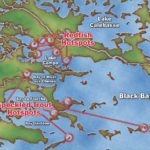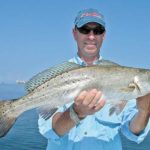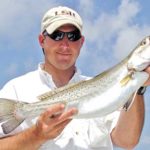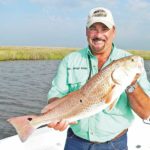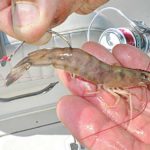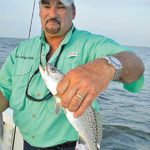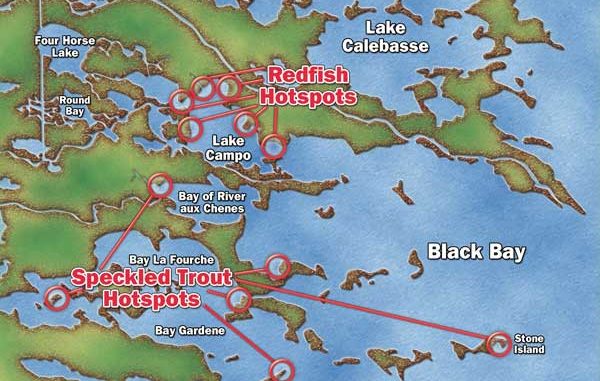
You won’t strike out fishing from this destination this month, and you might hit one out the park.
You know what they say in baseball — three strikes and you’re out. Well, I’m mighty close to strike three.
Let me explain: I recently journeyed to Cocodrie and did my first ever fishing trip out of it in order to write a feature story. I had a great trip with Capt. Ryan Young, caught some nice trout, took some great photos and went home to write the story.
But within a few days after my trip, they found an oil sheen and abruptly closed Cocodrie waters to fishing. Strike one.
I then scrambled to make an outing from Lafitte, a perennial summertime trout hotspot, and lined up a trip out of Joe’s Landing. I had a great trip with Capt. China, caught some nice trout, took some great photos and went home to write all about it when I got word that oil sheen was discovered on the surface and all of Lafitte’s prime speckled trout waters were closed to fishing. Strike two.
Now, I have to admit, I never was a very good baseball player (I was our team’s strike-out king, and when we took the field, they stuck me in right field and hoped no one would ever hit the ball out there), but I stepped up to the plate and decided to hit the ball or go out swinging. I made a desperate call to line up a trip out of Hopedale, and scored. But if I get word that Hopedale is closed to fishing, that’ll definitely be strike three.
These closures are changing almost as quickly as a baby’s diaper, and just keeping up with what is open and what is closed is exhausting.
One of the few remaining options for coastal anglers, those whose passion it is to chase speckled trout and redfish along the Southeast Louisiana coastline, is the Hopedale, Shell Beach and Delacroix Island area. As I write this, the area remains open. It was actually the first area initially closed to fishing, but then reopened when none of the defiling oil was found. I’m holding my breath in hopes that won’t change.
I met Capt. George Ricks (985-630-2923) at his dock in Hopedale, and loaded my gear into his 24-foot Nautic Star. We headed out just as the day was trying to break over the horizon. Ricks is a long-time friend of the family, and used to hunt with my dad. But I had a special reason for calling him for this trip: I knew he preferred to fish the islands on the fringes rather than go to the outside waters to fish trout and reds at the more-distant rigs and wells.
I figured if there was to be a closure in this area, it might only be for the outer waters and not include the fringe areas. As flawed as it might be, that was my thinking, and I knew that Ricks was catching fish without having to make the long hauls to the far outside.
The Ricks rationale
The captain explained his rationale for concentrating on the fringe islands rather than following the crowds to the rigs and structures in the summer months.
“There’s no doubt you can head out to the rigs and wells and catch fish this month,” he said. “Just look at the evidence when they post pictures of their catch on the internet. Plenty people go out there and catch fish, and nice fish at that. But they also pass up a lot of nice fish on their way out there.
“I look at it this way: When you hunt trout at the various rigs, you’re going to have to bounce around from rig to rig until you hopefully find them because the trout are always on the move out there. I choose to fish the islands because there’s usually always something there. The islands are especially good right around the full moon.”
Ricks, who fished the Bassmasters Tour professionally for nine years, and narrowly missed making the Classic in 1995, finishing 42nd in the nation, said trout have crazy libidos.
“Unlike bass, which spawn only once a year, speckled trout spawn throughout the summer,” he said. “That’s why they’re so numerous. They are prolific spawners, and even a 10-inch female will lay eggs.”
Ricks says to choose times with a good moving tide, either rising or falling, and concentrate at points with good tidal movement around them.
“You want to fish where the tide is hitting because that’s where the bait will stack up, and that’s where the fish will be,” he said. “I’ll fish everything from soft plastics to crankbaits and topwaters to live bait, whatever I can get them to hit on. I actually prefer to fish plastics if I can get away with it.
“But be sure to bring live bait, because sometimes that’s all they’ll hit. Live croakers under a cork or freelined with just a split shot 6 inches above the hook are excellent baits around the full moon because croakers love to eat the trout eggs. So the trout will attack a croaker to kill it even if they’re not hungry, just to keep it from devouring their eggs.
“If you’re fishing plastics around the full moon, toss something that looks like a croaker. And always bring some live shrimp whenever you head out. They’re still the cheapest part of the trip and the best insurance for success.”
We motored slowly to the narrow tip of a no-name island along the fringe of Lake Calabasse, and when we were within casting distance of the point, Ricks stuck the Power-Pole.
“See where the waves ripple over that section near the point?” he said, pointing. “That’s a shell-bottom reef that used to be part of the island. That’s the kind of thing you want to look for. If you’re unsure about what the bottom is like in an area, check it with your depth sounder, look for any rise from the bottom and feel it with a push pole. If it’s soft, keep looking. If you find hard bottom, fish it.”
Ricks says the fringe lakes are loaded with similar islands, and any of them should hold trout and reds.
We started casting toward the underwater reef with baits under popping corks. I tossed tandem-rigged white beetles, and Ricks threw a live shrimp. Naturally, he got the first strike, and reeled in a nice trout. He went right back out and caught another just like it, so I put my rig down and picked up another one I had pre-rigged with a kahle hook for live bait. I wanted in on that action! But when I grabbed a live shrimp from the bait well to string on my hook, Ricks stopped me.
“You’re not going to stick that hook through his head, are you?” he asked.
“Well, yeah, I was, why? You stick them through the tail?”
“No, not like you’re thinking,” he said. “Let me show you how to hook a live shrimp so he’ll stay alive and actually be able to swim more life-like.”
So I hooked my shrimp the Ricks way, and had a bite almost immediately. We sat there and caught trout after trout on our live shrimp for the next hour or so. It was a little bit more trouble to get used to hooking them through the back (and I’m sure I would have caught just as many had I hooked them through the head like I always do), but I did learn a trick or two. The shrimp did stay on the line better when hooked the Ricks way. I didn’t lose a single shrimp when casting, and that alone is saying something.
Ricks says the advantage is even more noticeable when hooking the much softer white shrimp in the fall. And my shrimp most definitely stayed alive longer when hooked the Ricks way. A couple of times I had a short strike where the fish just bit off the head of the shrimp, but both times I tossed out the remaining tail and caught a trout on it! And you often get short strikes when you hook them through the head and the fish just bite off the body. I chalk that up to smaller fish.
We were near a limit of trout, so I suggested we try to pick up a few reds before calling it a day. Ricks headed to one of his nearby hotspots, and stuck us within casting distance of the shoreline in a big cove. He tried a shallow-diving crankbait, while I wisely stayed with the live shrimp under a cork.
This time, I caught the fish, and it was Ricks who had to switch to the live stuff to try to catch up. We played along that shoreline for less than an hour and put six nice reds in the boat, and I missed a several more by talking too much, enjoying the scenery and not paying attention.
Ricks says if you want to put some reds in your box this month, you can pretty much forget the inside ponds. Most of them will be either grassed over from all the fresh water, or they’ll just be too hot.
“The best bet is to fish coves and points in the lakes this month,” he said.
He looks for points and shorelines with shells on the bank, and signs of mullet in the water.
“If you see mullet, the reds should be in there,” he said.
Gold spoons, beetle-spins, soft plastics, shallow crankbaits and live shrimp or market shrimp under popping corks will produce.
As long as this fishing area remains open, you’ll have a great opportunity to hit some home runs.
Capt. George Ricks can be reached at 985-630-2923.
